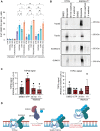RAD54L2 counters TOP2-DNA adducts to promote genome stability
- PMID: 38055822
- PMCID: PMC10699776
- DOI: 10.1126/sciadv.adl2108
RAD54L2 counters TOP2-DNA adducts to promote genome stability
Abstract
The catalytic cycle of topoisomerase 2 (TOP2) enzymes proceeds via a transient DNA double-strand break (DSB) intermediate termed the TOP2 cleavage complex (TOP2cc), in which the TOP2 protein is covalently bound to DNA. Anticancer agents such as etoposide operate by stabilizing TOP2ccs, ultimately generating genotoxic TOP2-DNA protein cross-links that require processing and repair. Here, we identify RAD54 like 2 (RAD54L2) as a factor promoting TOP2cc resolution. We demonstrate that RAD54L2 acts through a novel mechanism together with zinc finger protein associated with tyrosyl-DNA phosphodiesterase 2 (TDP2) and TOP2 (ZATT/ZNF451) and independent of TDP2. Our work suggests a model wherein RAD54L2 recognizes sumoylated TOP2 and, using its ATPase activity, promotes TOP2cc resolution and prevents DSB exposure. These findings suggest RAD54L2-mediated TOP2cc resolution as a potential mechanism for cancer therapy resistance and highlight RAD54L2 as an attractive candidate for drug discovery.
Figures




References
MeSH terms
Substances
Grants and funding
LinkOut - more resources
Full Text Sources
Other Literature Sources
Molecular Biology Databases
Research Materials
Miscellaneous

